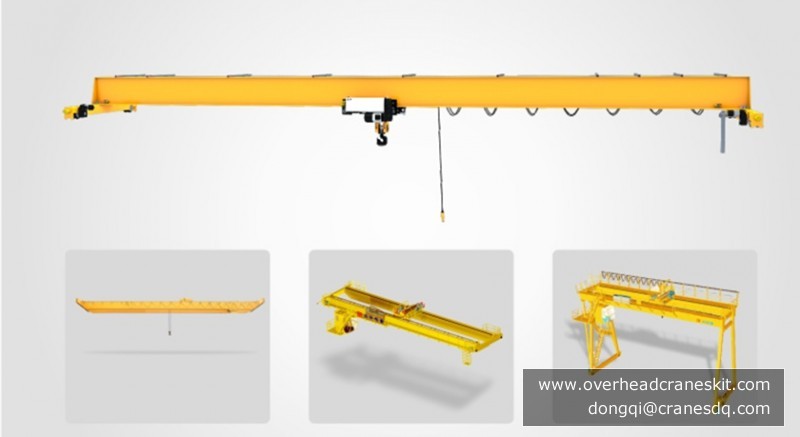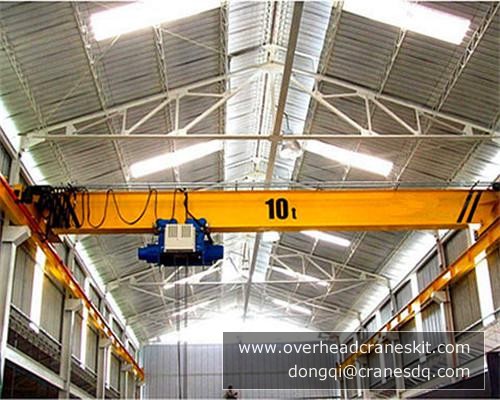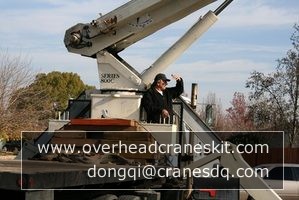Dongqi 2 Ton Bridge Crane Leaves Your Demands Now2 ton bridge crane is a type of overhead crane, can be classified into portable or mobile bridge crane. As a light weight bridge crane, 2 ton bridge crane is widely used in factory, coal mine, harbor, warehouse and workshop to lift, move or load materials. A 2 ton bridge crane can best meet the requirements of high-safety and productivity in factories.
Tagged: crane
Under hung bridge crane, also called under slung bridge crane or under running bridge crane, which are designed for flexibility and functionality. Because the under hung system is usually lighter than top running system, so a under hung overhead crane can be hung in the building structure directly without support. Compared with top running bridge crane, under hung overhead crane is more suitable for factory that height is limited.
Differ with under hung bridge crane; top running overhead crane is designed to lift massive loads. Generally, a top-running system is much heavier than under hung equipment. For top-running systems, the end trucks are supported on rails, which are attached to the top of the crane runway. Besides, as the best and efficient lifting solution in large coverage facility, top running overhead crane or bridge crane can be designed in both single girder, double or box girder, there are enough options to suit your demands.
Warehouse overhead crane is a kind of overhead crane, which mainly be made to adapt various types of warehouse. Using a warehouse overhead crane, commodities or material substance will be moved or lifted easily. Overhead crane for warehouse can be divided into different modes. In the light of girder, warehouse bridge crane can divide into singer girder overhead crane and double girder overhead crane. While on the basis of work duty, a warehouse bridge crane contains light-duty overhead cranes and heavy-duty bridge crane. There are two distinct control forms supplied for the warehouse overhead crane, one is ground control with a rope handle, another is the remote control. A customized crane also would be produced by our company on the basis of clear requirements.
The small overhead crane usually has one hoisting appliance; it makes single movement of materials need to lift. Due to compact structure and simple operation, small bridge crane commonly used in workshop, warehouse, dock storage and other place. There are various kinds of small bridge crane, such as wheel jack, manual or electric hoist, single girder overhead crane and all kinds of winches. Additional, our company also can custom crane to meet all your requirements.
The Occupational Safety and Health Administration (OSHA) defines a crane as a machine that lifts loads vertically and moves the loads horizontally with a hoisting device. Overhead cranes, tower cranes, mobile cranes, gantry cranes and jib cranes have hoisting devices located on the machines that require a daily inspection and checklist filled out before operation. The safety checklist is different for each type of crane, but most of the checklists have similar sections.
Some states require certification and/or licensing to operate a crane, while others such as Virginia have yet to enact such regulation. Setting aside the regulation, gaining crane-operator certification form the National Commission for the Certification of Crane Operators (NCCCO), located in Fairfax, Va., can boost employers’ confidence levels when making hiring decisions. Certification helps employers ascertain your knowledge and expertise in operating a crane system, as well as gauge your commitment to safety on the job.
Construction and manufacturing companies commonly use overhead cranes in their operations to transport materials. While useful, they also introduce potentially grave dangers. Each year, overhead crane accidents cause severe injuries or deaths. To prevent disasters, recognize specific hazards that occur during use and follow the safety guidelines and procedures to avoid them.
Cranes trucks have a myriad of uses from moving heavy objects to loading supply ships and hoisting equipment. That is why safe operation of these vehicles is critical. Operators must learn to use crane trucks properly and safely so costly accidents and serious injuries can be averted. Read on to learn more.
Crane operators are required to be certified by a third party training agency or a qualified trainer through their employer, according to the National Commission for the Certification of Crane Operators (NCCCO). This certification is required under a ruling from the Occupational Safety and Health Administration (OSHA) that took effect on November 8, 2010. These certification requirements are for operators of mobile, tower, overhead and articulating cranes.
Overhead cranes come in many forms. The crane can run on rails, gantries or just hang on a beam attached to a wall. Cranes can be controlled by an attached handset, from a cab or by a remote control device. No matter what style of crane, the operator must inspect it before use.
Cranes are large machines, generally used on construction sites to lift, move or work on heavy or inaccessible areas. These machines are meant to be used to help make the work site safer for construction workers by not requiring them to try to lift a heavy object or get into an unsafe work area. Cranes must be periodically inspected for safety and maintained to ensure that they are helping to keep workers safe rather than posing a possible hazard.
Crane operators require certification across North America. Quebec has only one crane operator training school: Atelier-ecole Les Cedres, which offers training only in French. There are other schools nearby, in Nova Scotia and Ontario, that offer training in English. Always check that the certification you are receiving will be accepted in the jurisdiction where you intend to work.
According to the Associated General Contractors of America, there are an average of 22 deaths each year related to crane operation. In response to this statistic, in August, 2010, the Occupational Safety and Health Administration adopted regulations that all overhead crane operators be qualified and certified. Section 1926.1427 of the U.S. Department of Labor (Federal Register), Cranes and Derricks in Construction Final Rule outlines the requirements for training to receive either certification or qualification.
Cranes are traditionally used in the construction industry or where there is a need to move heavy items. Cranes use a pulley system to reduce the strain and increase the weight that can be moved. Some cranes have magnets rather than hooks to grab items and move them. A model crane can be built using simple craft items and supplies from around the home. This model can be built with either a magnet or hook.
Gantry cranes lift heavy objects, particularly in the construction and shipbuilding industries. Different types of gantry cranes are used for various purposes. Gantry cranes lift objects using a hoist that fits on a horizontal beam or girder and moves horizontally. Two support pillars support the beam, and the hoist carries objects from one point to another overhead. Gantry cranes have powered rails at the bottom or wheels that can move the crane to different locations.
A gantry crane is a structure that has at least two legs that support a bridge or beam. The device allows you to move loads from one location to another. You see larger gantry cranes along shipyards or train stockyards. The crane will lift a load and move it horizontally to a desired location. You can build one of these devices to use in your workshop or garage to lift loads, such as engines, logs or other articles that are too heavy to lift manually. With a little welding knowledge and some mechanical aptitude, you can build a gantry crane.
Crane operators are most visible at demolition and construction sites, though many find employment in a variety of related industries. In addition to being in good physical condition, the ability to multitask is key in operating a crane, as an operator must be able to maneuver several controls simultaneously while accurately judging spaces.



















